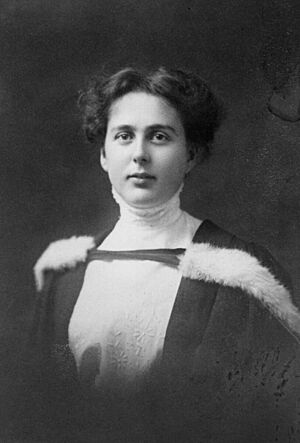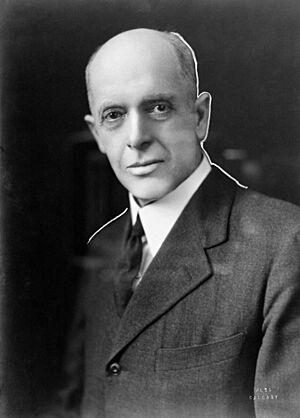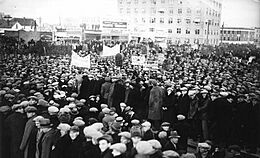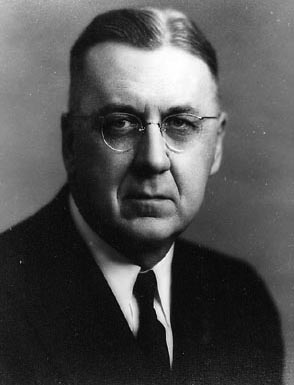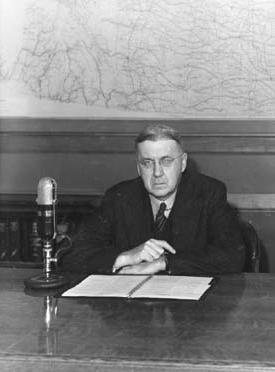John Edward Brownlee facts for kids
Quick facts for kids
John Edward Brownlee
|
|
|---|---|
 |
|
| 5th Premier of Alberta | |
| In office November 23, 1925 – July 10, 1934 |
|
| Monarch | George V |
| Lieutenant Governor | William Egbert William L. Walsh |
| Preceded by | Herbert Greenfield |
| Succeeded by | Richard G. Reid |
| Member of the Legislative Assembly of Alberta for Ponoka | |
| In office December 9, 1921 – August 22, 1935 |
|
| Preceded by | Percival Baker |
| Succeeded by | Edith Rogers |
| Alberta Provincial Secretary | |
| In office June 15, 1926 – July 10, 1934 |
|
| Preceded by | George Hoadley |
| Succeeded by | Richard G. Reid |
| In office 1923 – November 23, 1925 |
|
| Preceded by | Herbert Greenfield |
| Succeeded by | George Hoadley |
| Attorney-General of Alberta | |
| In office August 31, 1921 – June 5, 1926 |
|
| Preceded by | John R. Boyle |
| Succeeded by | John Lymburn |
| Personal details | |
| Born | August 27, 1883 Port Ryerse, Ontario, Canada |
| Died | July 15, 1961 (aged 77) Calgary, Alberta, Canada |
| Political party | United Farmers of Alberta |
| Spouse | Florence Edy |
| Children | 2 |
| Alma mater | University of Toronto |
| Occupation |
|
| Signature |  |
John Edward Brownlee (born August 27, 1883 – died July 15, 1961) was an important Canadian politician. He served as the fifth Premier of Alberta, leading the province from 1925 to 1934. Born in Port Ryerse, Ontario, he first studied history and political science at the University of Toronto. Later, he moved west to Calgary to become a lawyer.
Brownlee worked for the United Farmers of Alberta (UFA), a group that helped farmers. This connection led him to help start the United Grain Growers (UGG), a company owned by farmers. When the UFA won the 1921 election, the new Premier, Herbert Greenfield, asked Brownlee to be his Attorney-General (the province's chief legal officer). Brownlee agreed and was elected to the Legislative Assembly of Alberta.
As Attorney-General, Brownlee played a key role in the government. He helped farmers in dry areas and worked to sell off money-losing railways. He also fought to gain control of Alberta's natural resources from the federal government. In 1925, Brownlee became Premier after other UFA members asked him to take over from Greenfield.
As Premier, Brownlee had early successes. He won the 1926 election easily. He also signed a deal that gave Alberta control over its natural resources. He sold the government's railways and managed to keep the province's budget balanced. However, when the Great Depression hit, things became very tough. Brownlee resigned as Premier in 1934. He later returned to practicing law and managed the United Grain Growers company until shortly before his death in 1961.
Contents
Early Life and Education
Growing Up in Ontario
John Edward Brownlee was born on August 27, 1883, in Port Ryerse, Ontario. His parents were William and Christina Brownlee. His father ran the local general store. John had one sister, Maude.
Young John loved books and listening to his parents talk about politics. He was a serious child. One story says other kids once threw him into Lake Erie because he was so serious! By age seven, he was already helping in the family store.
In the late 1880s, Port Ryerse began to decline. Railways made small lake ports less important. So, his family moved to Bradshaw in Lambton County, Ontario. There, John started school and attended Sunday school. He was the only student not from a farm, which helped him understand farmers' lives early on.
High School and Early Work
In 1897, Brownlee started high school in Sarnia. He had to live away from his family because it was too far to travel daily. He was a very hard-working student, though not the most social. He graduated in 1900.
After high school, Brownlee helped with his family's business. His family hoped he would become a teacher. In 1901, he enrolled in Sarnia Model School. He completed a 15-week program and became a teacher in Bradshaw.
Brownlee was a good teacher. He was serious and disciplined, and his tall height gave him a strong presence. But his salary wasn't enough for his goals. In 1904, he decided to go to university. To earn money, he spent the summer selling encyclopedias in Manitoba. This trip gave him his first look at Western Canada.
University Days
In 1904, Brownlee enrolled at Victoria College at the University of Toronto. He studied history and political science. He also took classes in mathematics, biology, English literature, and languages like German and Hebrew.
He continued to be a diligent student, earning high grades. As he got more involved in school activities, his grades dropped slightly. He graduated in 1908.
Brownlee was active in many clubs. He joined the Union Literary Society, where he practiced debating. He also worked on the college's literary journal, Acta Victoriana, managing its business side. He even wrote funny skits for a satirical show called "the Bob." These activities helped him develop his skills.
Family Life
In 1908, Brownlee got engaged to Isabella Govenlock, a classmate. But the engagement didn't last. The next winter, he met Florence Edy, another university student. In 1909, Florence and her family moved to Calgary. Brownlee soon followed her there. They married on December 23, 1912.
John and Florence had two sons: John Edy Brownlee, born in 1915, and Alan Marshall Brownlee, born in 1917. Sadly, they also had a daughter in 1919 who died as a baby. Florence's health was not good after her pregnancies. Brownlee's sister, Maude, came from Ontario to help care for the children. Later, they hired a full-time maid.
Florence missed her family in Ontario. Her health worries were made worse by her sons' health issues. From 1921, John worked in Edmonton during the week, only coming home to Calgary on weekends. In 1923, the family moved to Edmonton.
Even though Brownlee seemed very serious in public, he was funnier at home. One Christmas, he left coal dust footprints and a note from Santa Claus for his sons. Another time, he got a large bloodhound for his sons, which he also enjoyed.
Legal Career and Farmers' Advocate
Becoming a Lawyer
After university, Brownlee chose to become a lawyer. Instead of law school, he trained by working for three years as an articled clerk in a law firm. He moved to Calgary because it offered good chances for young lawyers.
He worked for a firm that included R. B. Bennett, who later became Prime Minister of Canada. Brownlee learned a lot from Bennett. In 1912, Brownlee officially became a lawyer in Alberta. He became a partner in his firm in 1914.
Working for Farmers
One of Brownlee's main clients was the United Farmers of Alberta (UFA). He helped them create a farmer-owned company to manage grain elevators (buildings that store grain). This company was called the Alberta Farmers' Cooperative Elevator Company (AFCEC).
Brownlee became the AFCEC's lawyer. His most important work was helping the AFCEC merge with another company, the Grain Growers' Grain Company (GGG), to form the United Grain Growers (UGG). This merger happened on September 1, 1917.
As the UGG's lawyer, Brownlee saw how difficult it was for farmers to deal with big businesses. He believed the UGG should expand into other areas like insurance to help farmers be more independent. He also helped the UGG sell its shares in a bank quietly when they worried the bank was in trouble. This careful advice saved the UGG from losses when the bank later failed.
In 1919, Brownlee left his law firm to work full-time for the UGG. He was doing very well in both law and business. In 1922, he was made King's Counsel, a special title for experienced lawyers.
Getting Involved in Politics
Brownlee also worked with leaders of the UFA, like Henry Wise Wood, the UFA's president. Brownlee often went with Wood to speak to UFA groups across Alberta. Wood talked about cooperation and fairness, while Brownlee explained the UFA's services and answered legal questions. These trips made Brownlee more interested in politics.
In 1921, the UFA decided to run candidates in the provincial election. Brownlee did not expect them to win many seats. However, the UFA won 38 out of 61 seats, a big surprise!
The UFA was not a traditional political party and didn't have a leader. Henry Wise Wood was the obvious choice for Premier, but he refused. To Brownlee's surprise, Wood suggested Brownlee should become Premier. Brownlee also declined, thinking that an urban lawyer might not be the best choice for a farmer-led government. Eventually, Herbert Greenfield was chosen as Premier.
Serving as Attorney-General
Premier Greenfield appointed Brownlee as his Attorney-General. Soon after, Brownlee was elected in a special election in Ponoka. His background in law and business was unique in the UFA government. This made him very important in many government plans. He also defended the government against attacks from the opposition.
Brownlee was part of the more careful side of the UFA. He didn't want to give too much power to UFA groups outside the government. He also thought a government-owned bank was not possible. He was very concerned about the government's money. He even cut staff in his own department to save money. He also tried to sell the government's four money-losing railways.
A long-standing goal for Alberta was to gain control of its lands and natural resources from the federal government. Older provinces already had this control. As Attorney-General, Brownlee was Alberta's main negotiator in these talks. He met often with representatives of Prime Minister William Lyon Mackenzie King. The talks were difficult, but Brownlee kept pushing for Alberta's rights.
The UFA government wanted to help farmers in the dry southern parts of the province. Brownlee wrote the Drought Relief Act. This law helped farmers get financial advice and deal with their debts. He also played a big part in creating the Alberta Wheat Pool, a cooperative for farmers to sell their grain.
Brownlee's department was also in charge of enforcing prohibition (the ban on alcohol). But many people ignored the law, and it was hard to enforce. A public vote decided to replace prohibition with government-owned liquor stores. Brownlee also had to enforce the Lord's Day Act, which limited business on Sundays, but he didn't enforce it strictly.
Many UFA members felt that Premier Greenfield was not a strong leader. They wanted Brownlee to replace him. In 1925, Brownlee finally agreed. He became Premier of Alberta on November 23, 1925.
Leading Alberta as Premier
First Term: Success and Growth (1926–1930)
When Brownlee became Premier, his main goals were to gain control of Alberta's natural resources, sell the money-losing railways, and balance the provincial budget. First, he needed to win the next election. He did, winning 43 seats in the 1926 election. This gave the UFA a strong majority.
After the election, Brownlee focused on his goals. Many of them needed the help of the federal government led by Prime Minister King. King's government needed the support of UFA Members of Parliament (MPs) to stay in power. Brownlee used this to his advantage.
Brownlee worked hard to get control of natural resources for Alberta. After long talks, an agreement was finally signed on December 14, 1929. This was a huge victory for Alberta. Brownlee was welcomed back to Alberta by thousands of cheering supporters.
He also succeeded in selling the government's railways. After trying to sell them to big railway companies like CNR and CPR, the government ran them directly for a while. In 1928, they started making a profit. By the end of 1928, the remaining lines were sold to the CPR for $25 million. Brownlee was praised for his excellent negotiating skills.
With control of natural resources and the railway sales, Alberta's budget became balanced. Brownlee still pushed for careful spending. He also tried to get the federal government to pay more for new social programs like the old age pension. His focus on saving money made him less popular with some people.
Brownlee's government also tried to improve education. They wanted to combine Alberta's many small school districts into fewer, larger ones. This plan was meant to make province-wide reforms easier. However, people in rural areas worried it would close their local schools, so the plan was stopped.
Second Term: Facing the Great Depression (1930–1934)
Brownlee was re-elected in the 1930 election, though with a slightly smaller majority. But by then, the Great Depression was hitting Alberta hard. The price of wheat, Alberta's main export, dropped sharply. This caused huge problems for farmers and the Alberta Wheat Pool. Banks stopped lending money, making it hard for farmers to even buy seeds.
As farms failed, many young people moved to cities, but jobs were scarce there too. Unemployment rose, and there were many protests. In December 1932, over a thousand unemployed people tried to march to the Alberta legislature in Edmonton. Brownlee asked the city to stop the march. He worried it would lead to radical ideas. When the marchers tried to go ahead, police broke up the protest. Brownlee received much of the blame.
The UFA itself also shifted left, with Robert Gardiner becoming president. This made Brownlee's job even harder.
The economic crisis severely affected the provincial government's money. In 1931, Brownlee's government had its first budget deficit. In 1932, Alberta almost couldn't pay back a $3 million loan. They only avoided this by getting a loan from the federal government. Brownlee cut spending drastically. He closed most agricultural colleges, reduced government staff by more than a third, and cut salaries. He even replaced the Alberta Provincial Police with the Royal Canadian Mounted Police (RCMP) to save money.
His government also increased taxes on companies and introduced a new provincial income tax. These measures were not enough. Brownlee asked Prime Minister R. B. Bennett for help, but Bennett refused.
In 1933, Brownlee was appointed to a special commission about banking. He argued that banks treated western farmers unfairly. He also suggested that Canada should have a central bank controlled by the public. This idea later became a reality in 1938.
During the Depression, a teacher named William Aberhart became popular by preaching about a new economic idea called social credit. Brownlee believed Aberhart's ideas wouldn't work and were against the constitution. As Aberhart gained followers, Brownlee criticized his plans but didn't have easy solutions of his own.
Later Political Life
Brownlee resigned as Premier in 1934. He kept a low profile for a while but remained an MLA for Ponoka. In January 1935, he spoke at a UFA meeting, warning against Aberhart's social credit plans. He said that Alberta could not implement such a system alone because the province didn't control money.
Brownlee became a key person in the government's fight against Aberhart. He even invited the original social credit theorist, C. H. Douglas, to Alberta. Brownlee hoped this would show how different Aberhart's ideas were from Douglas's. But people preferred the energetic Aberhart to the distant Douglas.
Brownlee also toured southern Alberta, arguing that Aberhart's policies were vague and unconstitutional. He gave radio speeches to counter Aberhart's popular program. When logic didn't work, Brownlee started attacking Aberhart personally. He compared Aberhart to the Pied Piper, who led children away. Aberhart replied that the Pied Piper got rid of "rats" (meaning politicians like Brownlee). Brownlee then said the Piper led children to their destruction.
The 1935 election was held on August 22. Brownlee focused on keeping his own seat in Ponoka. But his voters were suffering economically and were tired of the UFA's traditional approach. Brownlee recalled a farmer telling him, "What have I got to lose?" by trying something new.
On election day, every UFA candidate, including Brownlee, was defeated. Aberhart's Social Credit party won a huge victory, taking 56 out of 63 seats. Brownlee lost his seat to Edith Rogers. After this, Brownlee never ran for political office again.
Life After Politics
After his election defeat, Brownlee started a new law firm in Edmonton. The United Grain Growers (UGG) soon hired him again as their main lawyer. By 1940, his career was strong again. His firm had many big agricultural companies as clients.
Brownlee helped restructure the UGG. He created two types of shares: investment shares for anyone and voting shares only for farmers. This helped the company get more money while keeping farmers in control.
UGG Director and President
In 1942, Brownlee was elected to the UGG's board of directors and became vice president. He helped the UGG with a big income tax dispute. He argued that the UGG should have the same tax exemptions as other farmer cooperatives. After much effort, the government agreed.
In 1948, Brownlee became the President and General Manager of the UGG. He worked constantly, often bringing home briefcases full of work. His staff knew him as a man whose life was his work.
He focused on expanding the company, building and buying new grain elevators. He also worked to make the UGG more efficient. He helped the UGG work with competitors in small towns that could only support one elevator. He also increased the UGG's presence in larger cities.
Brownlee remained very involved in the grain industry. He advised the Canadian delegation on international agreements, helping farmers get better prices for their grain. He also argued against railway companies raising their rates for shipping grain.
In 1956, the UGG celebrated its 50th anniversary. Brownlee traveled around the country speaking to UGG branches. He also oversaw and wrote much of The First Fifty Years, a history of the UGG.
On June 21, 1961, Brownlee resigned from the UGG due to poor health.
Later Activities and Personal Life
Brownlee rarely commented on political issues after 1935. However, he did advise the Social Credit government behind the scenes on some matters.
His sons became successful. Alan became a lawyer and joined his father's firm. John became a photographer. Both married and had children. Brownlee eventually gave his law firm to Alan and moved back to Calgary with his wife.
In his later years, Brownlee received several honors. He was inducted into Manitoba's Order of the Buffalo Hunt in 1960. The UFA gave him an honorary life membership. Prime Minister John Diefenbaker appointed him to the National Productivity Council, but Brownlee's health prevented him from participating.
Brownlee had several major surgeries starting in 1957. His memory began to fail. He died on July 15, 1961, shortly after resigning from the UGG.
Legacy and Impact
Many of Brownlee's achievements as Premier are not widely remembered today. However, historians often praise him. Some call him "Alberta's greatest premier." They point to his success in getting control of natural resources for Alberta. This deal helped Alberta become a wealthy province due to oil and gas royalties.
A study in 2005 ranked Brownlee as Alberta's third greatest premier.
Brownlee's impact is also seen through the organizations he helped build. The Alberta Wheat Pool was important in Canadian agriculture for many years. It later merged with other companies to form Agricore United, and then Viterra. Brownlee's idea of a publicly controlled central bank also came true in 1938 with the Bank of Canada.
Brownlee was buried near Edmonton. The John E. Brownlee Building in Edmonton is named in his honor. The University of Alberta Faculty of Law also has a prize named after him.
Electoral Record
As Party Leader
| 1926 Alberta provincial election | |||||||||
|---|---|---|---|---|---|---|---|---|---|
| Party | Party Leader | # of candidates |
Seats | Popular Vote | |||||
| 1921 | Elected | % Change | # | % | % Change | ||||
| United Farmers | John E. Brownlee | 46 | 38 | 43 | +13.2% | 71,967 | 39.68% | +10.76% | |
| Liberal | Joseph Tweed Shaw | 54 | 15 | 7 | -36.4% | 47,450 | 26.17% | -7.90% | |
| Labour | 12 | 4 | 5 | +25.0% | 14,123 | 7.79% | -3.25% | ||
| Conservative | Alexander McGillivray | 56 | - | 4 | 40,091 | 22.10% | +11.12% | ||
| Independent Labour | 1 | - | 1 | 2,467 | 1.37% | -1.69% | |||
| Independent Liberal | 5 | - | - | 2,728 | 1.51% | 1.02% | |||
| Independent | 3 | 4 | - | -100% | 1,254 | 0.70% | -8.96% | ||
| Independent UFA | 5 | - | 999 | 0.55% | |||||
| Liberal–Progressive | A. D. Campbell | 1 | - | 252 | 0.13% | ||||
| Total | 183 | 61 | 60 | - | 181,331 | 100% | |||
| 1930 Alberta provincial election | |||||||||
|---|---|---|---|---|---|---|---|---|---|
| Party | Party Leader | # of candidates |
Seats | Popular Vote | |||||
| 1926 | Elected | % Change | # | % | % Change | ||||
| United Farmers | John E. Brownlee | 47 | 43 | 39 | -9.3% | 74,187 | 39.41% | -0.27% | |
| Liberal | George Harry Webster | 36 | 7 | 11 | +57.1% | 46,275 | 24.59% | -1.58% | |
| Conservative | David Milwyn Duggan | 18 | 5 | 6 | +20.0% | 27,954 | 14.85% | -7.25% | |
| Labour | Fred J. White | 11 | 5 | 4 | -20.0% | 14,354 | 7.63% | -0.16% | |
| Communist | 1 | ||||||||
| Independent | 28 | - | 3 | 25,449 | 13.52% | +12.82% | |||
| Total | 141 | 61 | 63 | +3.3% | 188,219 | 100% | |||
As MLA
| Alberta provincial by-election, December 9, 1921: Ponoka Following the death of Percival Baker on July 19, 1921. |
||||||||
|---|---|---|---|---|---|---|---|---|
| Party | Candidate | Votes | % | ±% | ||||
| United Farmers | John Edward Brownlee | Acclaimed | – | – | ||||
| Total | – | – | – | |||||
| United Farmers hold | Swing | – | ||||||
|
Source(s)
Mardon 107 |
||||||||
| Alberta general election, 1926: Ponoka | ||||||||
|---|---|---|---|---|---|---|---|---|
| Party | Candidate | Votes | % | ±% | ||||
| United Farmers | John Edward Brownlee | 1,357 | 62.91% | -0.14% | ||||
| Liberal | Marcus Crandall | 453 | 21.00% | -15.94% | ||||
| Conservative | Arthur Beaumont | 347 | 16.09% | – | ||||
| Total | 2,157 | – | – | |||||
| Rejected, spoiled and declined | N/A | – | – | |||||
| Eligible electors / turnout | 3,207 | 67.26% | – | |||||
| United Farmers hold | Swing | 7.90% | ||||||
|
Source(s)
Source:
See Mardon 107 |
||||||||
| Alberta general election, 1930: Ponoka | ||||||||
|---|---|---|---|---|---|---|---|---|
| Party | Candidate | Votes | % | ±% | ||||
| United Farmers | John Edward Brownlee | Acclaimed | – | – | ||||
| Total | N/A | – | – | |||||
| Rejected, spoiled and declined | N/A | – | – | |||||
| Eligible electors / turnout | N/A | N/A | – | |||||
| United Farmers hold | Swing | N/A | ||||||
|
Source(s)
Source:
See Mardon 107 |
||||||||
| Alberta general election, 1935: Ponoka | ||||||||
|---|---|---|---|---|---|---|---|---|
| Party | Candidate | Votes | % | ±% | ||||
| Social Credit | Edith Rogers | 2,295 | 59.30% | – | ||||
| United Farmers | John Edward Brownlee | 879 | 22.71% | – | ||||
| Liberal | Robert McLaren | 696 | 17.98% | – | ||||
| Total | 3,870 | – | – | |||||
| Rejected, spoiled and declined | N/A | – | – | |||||
| Eligible electors / turnout | 4,559 | 84.89% | – | |||||
| Social Credit gain from United Farmers | Swing | N/A | ||||||
|
Source(s)
Source: |
||||||||


